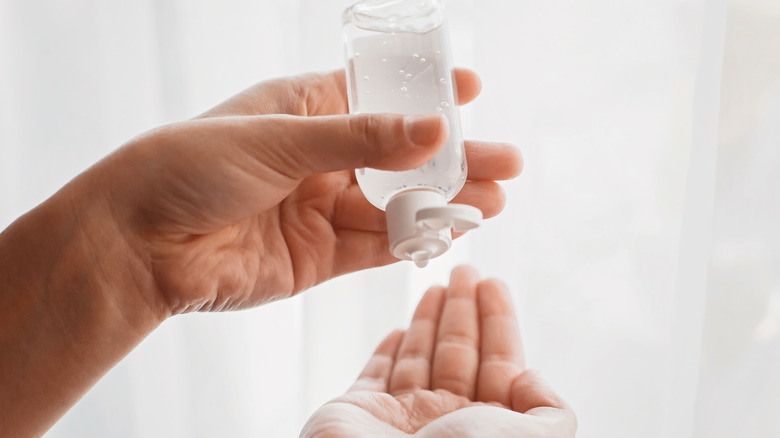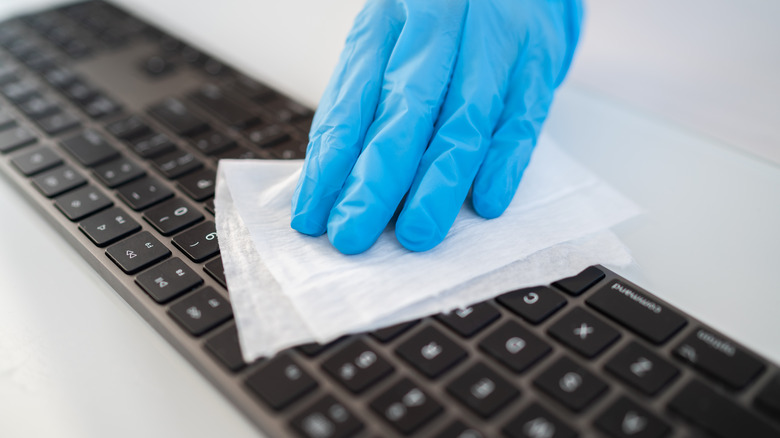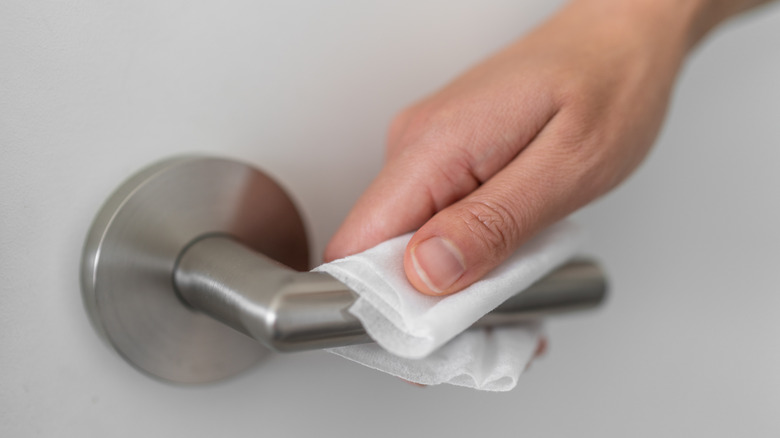The Most Important Place To Use Disinfectant That You're Probably Missing
The Covid-19 pandemic has had at least one positive result: More attention is now being paid to cleaning, sanitizing, and disinfecting the germs and viruses that lurk on every surface, appliance, and household item. Per MD Anderson, cleaning is not sufficient. Disinfecting as many germs as possible is a must as the last line of defense. Extra care must also be taken to combat any pathogens left behind by ill family members or visitors. According to Novant Health, however, one does not need to disinfect everything all the time. The goal is to reduce health risks as much as possible. Employing the one-two punch of cleaners and disinfectants, along with maintaining vigilant personal hygiene, increases your odds of remaining infection-free.
There are obvious targets for disinfecting your home. Think bathrooms, dog bowls, and the baby's changing table. There are also innumerable ones easy to overlook, including the big one: the kitchen sink. Simply stated, your kitchen sink is a moist breeding ground for bacteria including E. coli, campylobacter, and salmonella. Rinsing raw meat and poultry adds germs, as does hand washing, standing water, and repeatedly squeezing out the spoiled contents of sponges. It's your home's surprise number one haven for germs, so disinfect it daily.
According to microbiologist Chuck Serba as quoted in Today, even your toilet has less fecal bacteria than the place where you wash your food. Your kitchen sink is in constant need of sanitizing, along with its companions the sponges, dish towels, drain stopper, and countertops.
Other items to disinfect
Wash hands, and that goes for everyone in your house! Practice this ritual whenever you return from outside to avoid contaminating anything, and be sure to take extra measures if someone in your house is ill. Use soap or hand sanitizer with at least 60% alcohol. Note: A disinfectant's effectiveness is compromised if the germy object is not cleaned before using, per healthychildren.org. Fortunately, many disinfectants are household products that are readily available and inexpensive. Alcohol, bleach, hydrogen peroxide, and baking soda are effective. Follow safety protocols for their use and storage.
All frequently touched items must be included in a thorough regimen, the World Health Organization advises. Though contacted multiple times throughout the day, such objects are easy to take for granted and forget, but require daily cleaning. Cabinet and appliance handles, remote controls, phones, and keys are a few. Children's toys and play spaces, computer keyboards and mice, and window frames also require disinfecting. Don't ignore banisters, light switches, and floors, especially carpeted ones, which Rolling Stone suggests should be treated every few weeks. And the next time Fido soils that carpet, don't just wipe it clean — disinfect it.
Electronic devices and TV screens need to be disinfected as well, especially those with touchscreens. Exercise care when disinfecting electronics if using alcohol products. Cleaning the kitchen counter is a given, as already mentioned, but when you're focusing on the sink, don't forget the germ-ridden cutting board or the filthy reusable grocery bags hanging by the fridge.
Total disinfecting
Five essential weapons in the war against germs are bleach, rubbing alcohol, hand sanitizers, hand soap, and hydrogen peroxide, per Web MD. Vinegar is another. There is a litany of commonsense rules to follow for using these disinfectants safely. Never mix them. For instance, rubbing alcohol mixed with bleach will create chloroform, which can lead to loss of consciousness in extreme cases of exposure. Before using, determine what personal protective gear might be appropriate to protect you from any caustic ingredients, warns the CDC. Store all disinfectants safely away from children and pets, preferably in a locked or otherwise inaccessible cabinet. Keep Poison Control's number close at hand. Maintain adequate ventilation when using disinfectants and wash your hands when finished, either with soap or a hand sanitizer. MD Anderson mentions a homemade sanitizer derived from alcohol, glycerol, and hydrogen peroxide.
Household bleach, which is a 5.25% solution of sodium hypochlorite, is a potent, all-purpose disinfectant. A diluted mixture of 4 teaspoons of bleach in a quart of water is typically used and is effective on surfaces where norovirus pathogens dwell, such as doorknobs. It disinfects toilet slime as well (via Web MD). Be aware that the diluted bleach weakens gradually, and it should be prepared prior to each use rather than stored. DIY wipes can also be fashioned from paper towels soaked in bleach and wrung out. Leave no stone unturned when it comes to thoroughly disinfecting your house, and pay particular attention to that kitchen sink.


